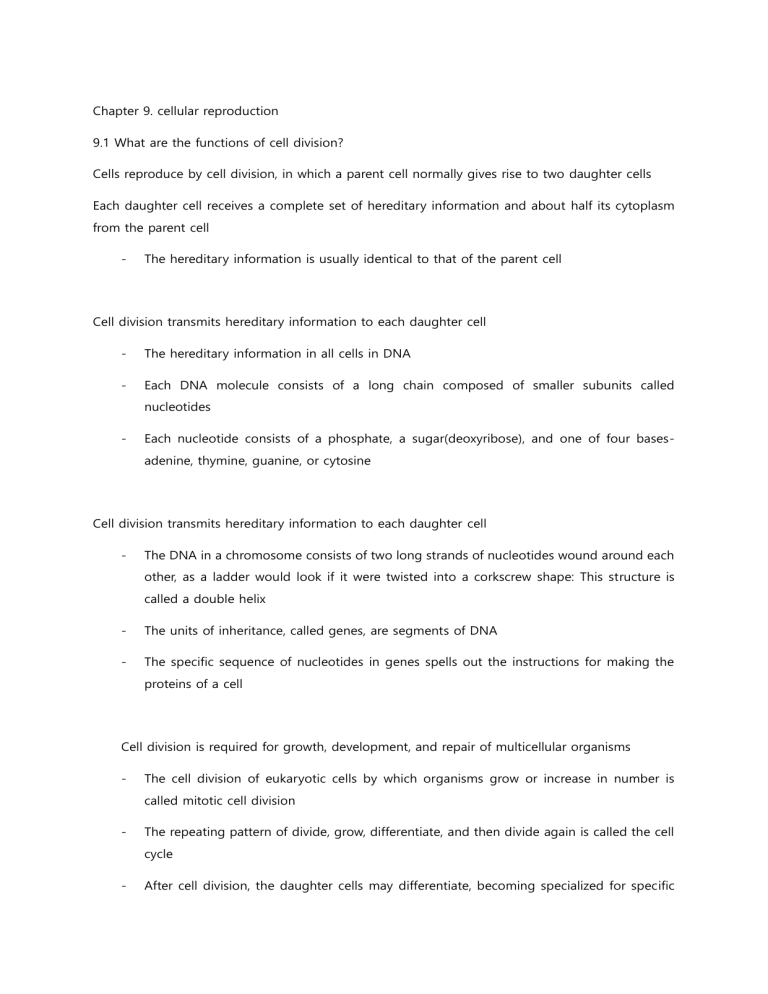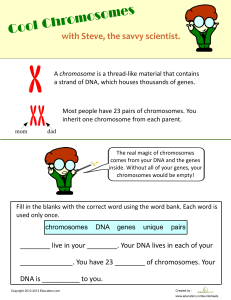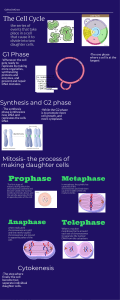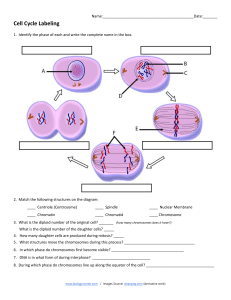
Chapter 9. cellular reproduction 9.1 What are the functions of cell division? Cells reproduce by cell division, in which a parent cell normally gives rise to two daughter cells Each daughter cell receives a complete set of hereditary information and about half its cytoplasm from the parent cell - The hereditary information is usually identical to that of the parent cell Cell division transmits hereditary information to each daughter cell - The hereditary information in all cells in DNA - Each DNA molecule consists of a long chain composed of smaller subunits called nucleotides - Each nucleotide consists of a phosphate, a sugar(deoxyribose), and one of four basesadenine, thymine, guanine, or cytosine Cell division transmits hereditary information to each daughter cell - The DNA in a chromosome consists of two long strands of nucleotides wound around each other, as a ladder would look if it were twisted into a corkscrew shape: This structure is called a double helix - The units of inheritance, called genes, are segments of DNA - The specific sequence of nucleotides in genes spells out the instructions for making the proteins of a cell Cell division is required for growth, development, and repair of multicellular organisms - The cell division of eukaryotic cells by which organisms grow or increase in number is called mitotic cell division - The repeating pattern of divide, grow, differentiate, and then divide again is called the cell cycle - After cell division, the daughter cells may differentiate, becoming specialized for specific functions Cell division is required for growth, development, and repair of multicellular organisms(continued) - Most multicellular organisms have three categories of cells 1. Stem cells 2. Other cells capable of dividing 3. Permanently differentiated cells Cell division is required for growth, development, and repair of multicellular organisms - Stem cells have two important characteristics: self-renewal and the ability to differentiate into a variety of cell types: -Stem cells self-renew because they retain the ability to divide, perhaps for the entire life of the organism -Stem cells include most of the daughter cells formed by the first few cell divisions of a fertilized egg, as well as a few adult cells - When a stem cell divides, usually one daughter remains a stem cell, thus continuing the line; the other daughter eventually differentiates - Some stem cells in early embryos can produce any of the specialized cell types of the entire body, a property called potency Cell division is required for growth, development, and repair of multicellular organisms(continued) - Other cells capable of dividing -Many cells of the bodies of embryos, juveniles, and adults can divide -Each type of cell typically differentiates into only one or two types of cells - Dividing liver cells, for example, can only become more liver cells - Permanently differentiated cells differentiate and never divide again Cell division is required for sexual and asexual reproduction - Sexual reproduction in eukaryotic organisms occurs when offspring are produced by the fusion of gametes (sperm and eggs) from two adults -Cells in the adult’s reproductive system undergo a specialized type of cell division called meiotic cell division - Products of meiotic cell division, such as gametes, have exactly half the genetic information of their parent cells and reestablish the full genetic complement when they fuse Cell division is required for sexual and asexual reproduction - Reproduction in which offspring are formed from a single parent, without having a sperm fertilized an egg, is called asexual reproduction -Clones are offspring genetically identical to the parent and to each other, produced through asexual reproduction - Bacteria and single-celled eukaryotic organisms reproduce asexually - Some multicellular organisms can reproduce asexually - Humans have cloned a variety of animals 9.2 What occurs during the prokaryotic cell cycle? The DNA of a prokaryotic cell is contained in a single, circular chromosome about a millimeter or two in circumference Unlike eukaryotic chromosomes, prokaryotic chromosomes are not contained in a membranebound nucleus The prokaryotic cell cycle consists of a relatively long period of growth followed by prokaryotic fission (or “splitting in two”) The prokaryotic fission occurs in five stages 1. At the start of the growth phase, the single prokaryotic chromosome is usually attached at one point to the plasma membrane of the cell 2. During the growth phase, the circular DNA chromosome replicates, producing two identical chromosomes that become attached to the plasma membrane at nearby but separate, sites 3. As the cell increases in size, new plasma membrane is added between the attachment points, pushing the duplicated chromosomes apart 4. The plasma membrane grows inward between the two chromosome copies 5. Fusion of membrane along the cell equator completes separation (binary fission) of the cells, producing two daughter cells, each containing one of the chromosomes: The daughter cells are genetically identical 9.3 How is the DNA is eukaryotic chromosomes organized? Eukaryotic chromosomes differ from prokaryotic chromosomes in important ways - Eukaryotic chromosomes are separated from the cytoplasm by a membrane-bound nucleus - Eukaryotic cells always have multiple chromosomes - Eukaryotic chromosomes are longer and have more DNA than prokaryotic chromosomes (human chromosomes have 10 to 50 times more DNA) - Each human chromosome contains a single DNA double helix, about 50 million to 250 million nucleotides long The eukaryotic chromosome consists of a linear DNA double helix bound to proteins - Most of the time, the DNA in each chromosome is wound around proteins called histones - These DNA-histone spools are further folded into coils - Another layer of folding occurs as the coiled strand folds into loops, which are then attached to protein scaffolding, so that the chromosome is 1,00 times shorter than the extended DNA molecule - During cell division, more proteins fold up the DNA and histones until the chromosome is 10 times shorter than during its resting state Every chromosome has specialized regains that are crucial to its structure and function - The two ends of a chromosome consist of repeated nucleotide sequences called telomeres, which are essential for chromosome stability Genes are segments of the DNA of a chromosome - The second specialized region of the chromosome is the centromere, which has two principal functions 1. It temporarily folds two daughter DNA double helices together after DNA replication 2. It is the attachment site for microtubules that move the chromosomes during cell division 9.4 What occurs during the eukaryotic cell cycle? The eukaryotic cell cycle consists of interphase and mitotic cell division - Interphase is a time for acquisition of nutrients, growth, and chromosome duplication - During cell division, one copy of every chromosome and half of the cytoplasm and organelles are parceled out into the two daughter cells During interphase, a cell grows in size, replicates, its DNA, and often differentiates - Most eukaryotic cells spend the majority of their time in interphase - Interphase is divided into three phases: - G1(growth phase 1) is a time for acquisition of nutrients and growth to proper size - S(synthesis phase) is characterized by DNA synthesis, during which every chromosome is replicated - G2(growth phase 2) includes completion of cell growth and preparation for division of the cell into daughter cells During interphase, a cell grows in size, replicates its DNA, and often differentiates (continued) - A newly formed daughter cell enters the G1 portions of interphase - During G1, a cell carried out three activities - 1. It grows in size 2. It specialized or differentiates Structures and biochemical pathways are developed, enabling the cell to perform specialized functions 3. It decides whether to divide - If a cell in G1 decides to divide, it enters the S phase, during which it replicates its DNA - The cell then proceeds to the G2 phase, where it grows more and makes the proteins needed for cell division - The cell cycle is carefully controlled throughout the life of an organism 1. Without enough cell divisions at the right time and in the right organs, development falters or body parts fail to replace worn-out or damages cells 2. With too many cell divisions, cancers may form Mitotic cell division consists of nuclear division and cytoplasmic division - Mitotic cell division is the division of one parental cell into two daughter cells; it consists of two processes: mitosis and cytokinesis - Mitosis is the division of the nucleus - During mitosis (nuclear division), the nucleus of the cell and the chromosomes divide 1. Each daughter nucleus receives one copy of each of the replicated chromosomes of the parent cell - During cytokinesis (cytoplasmic division), the cytoplasm is divided roughly equally between the two daughter cells, and one daughter nucleus enters each of the daughter cells - Mitotic cell division takes place in all eukaryotic organisms - It is the mechanism of asexual reproduction - Mitotic cell division followed by differentiation of the daughter cells allows a fertilized egg to grow into an adult with perhaps trillions of specialized cells - It allows organisms to maintain, repair, and even regenerate body parts - It is the mechanism whereby stem cells reproduce 9.5 How does mitotic cell division produce genetically identical daughter cells? Remember that a chromosome consists of genes, two telomeres, and one centromere - At the end of DNA replications, a duplicated chromosome consists of two identical DNA double helices, called sister chromatids, which are attached to each other at the centromere - During mitotic cell division, the two sister chromatids separate, each becoming an independent chromosome that is delivered to one of the two daughter cells For convenience, biologists divide mitosis into four phases based on appearance and behavior of the chromosomes Prophase -> metaphase -> Anaphases -> Telophase During prophase, the chromosomes condense, the spindle forms, the nuclear envelope breaks down, and the chromosomes are captured by the spindle microtubules - The first phase of mitosis is prophase (“the stage before” in Greek) - Four major events occur during prophase 1. Duplicated chromosomes condense 2. Spindle microtubules form 3. Nuclear envelope breaks down 4. Chromosomes are captured by the spindle microtubules - After condensations of the chromosomes, spindle microtubules form - The region from which the spindle microtubules originate contains a pair of microtubulecontaining structures called centrioles - Two types of spindle microtubules form: polar microtubules and kinetochore, a proteincontaining structure located at the centromere - The spindle microtubules radiate from the poles, both toward the nucleus, forming a basket around it, and outward toward the plasma membrane - The nuclear envelop disintegrates, releasing the duplicated chromosomes During metaphase, the chromosomes line up along the equator of the cell - At the end of prophase, the kinetochores of each duplicated chromosome are connected to spindle microtubules leading to opposite poles of the cell - Metaphase is a result of duplicated chromosomes connecting to opposite spindle poles - A kinetochore microtubule from one pole that is attached to a chromatid’s kinetochore lengthens or shortens as necessary to draw the chromosomes to the cell’s equator, in a line perpendicular to the spindle During anaphase, sister chromatids separate and are pulled opposite poles of the cell - At the beginning of anaphase, the sister chromatids separate, becoming independent daughter chromosomes - Motor proteins in kinetochores pull chromatids apart along the kinetochore microtubules and toward opposite poles - At about the same time, polar microtubules from opposite poles attach to one another where they overlap at the equator - These polar microtubules then simultaneously lengthen and push on one another, which forces the poles of the cell apart so that the cell assumes an oval shape During telophase, a nuclear envelope forms around each grow chromosomes - Telophase is the end stage of mitotic cell division 1. The spindle microtubules disintegrate 2. A nuclear membrane forms around each group of chromosomes at the pole 3. Chromosomes unwind and revert to their extended state 4. The nucleoli (which disappeared in prophase) reappear During cytokinesis, the cytoplasm is divided between two daughter cells - Cytokinesis differs greatly between animal cells and plant cells - In animal cells, microfilaments, attached to the plasma membrane form a ring around the equator of a cell - The ring contracts and constricts the cell’s equator - Eventually, contraction of the ring pinches off the membrane, forming two daughter cells with identical nuclei - Following cytokinesis, animal cells enter G1 of interphase, thus completing the cell cycle - In animal cells, microfilaments attached to the plasma membrane contract at the equator of the cell, dividing the cytoplasm - In plants, stiff plant cell walls prevent the “pinching off” of cytokinesis seen in animal cells, which only have a plasma membrane - Instead, carbohydrate-filled vesicles assemble along the cell’s equator, between the daughter nuclei - The vesicles fuse into a continuous flattened sac, surrounded by plasma membrane and filled with sticky carbohydrates called a cell plate 9.6 how it’s the cell cycle controlled? The activities of specific proteins drive the cell cycle - During development, after an injury, or to compensate for normal wear and tear, a variety of cells release growth factors, hormone-like molecules - The cell cycle is driven by proteins called cyclin-dependent kinases, or CDKs 1. Kinases are enzymes that phosphorylate (add a phosphate group to) other proteins, stimulating or inhibiting the protein’s activity 2. CDKs are “cyclin-dependent” because they are active only when they bind to other proteins called cyclins - Cell division occurs when growth factors bind to cell surface receptors, leading to cycling synthesis - Cyclins then bind to an activate specific CDKs - The cyclin-CDK complexes then stimulate the synthesis and activity of proteins that are required for DNA synthesis, causing the cell to enter S phase - Other CDKs become activated during G2 and mitosis and promote events in those phases 1. Chromosome condensation 2. Nuclear membrane breakdown 3. Spindle formation 4. - Attachment of chromosomes to the spindle Still other CDKs stimulate processes that allow the sister chromatids to separate into individual chromosomes and move to opposite poles of the cell during anaphase Check points regulate progress through the cell - - Although CDKs drive the cell cycle, multiple checkpoints ensure that 1. The cell successfully completes DNA synthesis during interphase 2. Proper chromosome movements occur during mitotic cell division There are three major checkpoints in the eukaryotic cell cycle, each regulated by protein complexes 1. At the juncture of G1 to S 2. At the juncture of G2 to mitosis 3. Between metaphase and anaphase - The G1 to S checkpoint ensures that the cell’s DNA is suitable for replication - The G2 to mitosis checkpoint ensures that DNA has been completely and accurately replicated - The metaphase to anaphase checkpoint ensures that all the chromosomes are attached to the spindle and aligned properly at the equator of the cell




